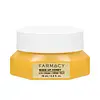What's inside
What's inside
 Key Ingredients
Key Ingredients

 Benefits
Benefits

 Concerns
Concerns

 Ingredients Side-by-side
Ingredients Side-by-side

Water
Skin ConditioningGlycerin
HumectantCoco-Caprylate/Caprate
EmollientPentaerythrityl Tetraisostearate
EmollientDiisostearyl Malate
EmollientButyrospermum Parkii Butter
Skin ConditioningCetearyl Alcohol
EmollientTetrahexyldecyl Ascorbate
AntioxidantCetearyl Olivate
Pentylene Glycol
Skin ConditioningHelianthus Annuus Seed Oil Unsaponifiables
EmollientSorbitan Olivate
EmulsifyingBoron Nitride
AbsorbentCaffeine
Skin ConditioningHyaluronic Acid
HumectantCeramide NP
Skin ConditioningVaccinium Macrocarpon Fruit Extract
AstringentCoffea Arabica Seed Extract
MaskingHoney Extract
HumectantPropolis Extract
Skin ConditioningRoyal Jelly Extract
Skin ConditioningCitrus Aurantium Amara Fruit Extract
Skin ConditioningCitrus Aurantium Sinensis Peel Extract
Skin ConditioningCitrus Reticulata Fruit Extract
Skin ProtectingAscorbic Acid
AntioxidantTridecapeptide-1
Skin ConditioningBetaine
HumectantTriolein
Skin ConditioningHydroxyacetophenone
AntioxidantTocopheryl Acetate
AntioxidantAstaxanthin
Skin ConditioningAllantoin
Skin ConditioningHippophae Rhamnoides Oil
EmollientTocopherol
AntioxidantUbiquinone
AntioxidantLecithin
EmollientHaematococcus Pluvialis Extract
AntioxidantGlyceryl Dioleate
EmollientWater, Glycerin, Coco-Caprylate/Caprate, Pentaerythrityl Tetraisostearate, Diisostearyl Malate, Butyrospermum Parkii Butter, Cetearyl Alcohol, Tetrahexyldecyl Ascorbate, Cetearyl Olivate, Pentylene Glycol, Helianthus Annuus Seed Oil Unsaponifiables, Sorbitan Olivate, Boron Nitride, Caffeine, Hyaluronic Acid, Ceramide NP, Vaccinium Macrocarpon Fruit Extract, Coffea Arabica Seed Extract, Honey Extract, Propolis Extract, Royal Jelly Extract, Citrus Aurantium Amara Fruit Extract, Citrus Aurantium Sinensis Peel Extract, Citrus Reticulata Fruit Extract, Ascorbic Acid, Tridecapeptide-1, Betaine, Triolein, Hydroxyacetophenone, Tocopheryl Acetate, Astaxanthin, Allantoin, Hippophae Rhamnoides Oil, Tocopherol, Ubiquinone, Lecithin, Haematococcus Pluvialis Extract, Glyceryl Dioleate
Water
Skin ConditioningGlycerin
HumectantDecyl Oleate
EmollientHydroxyethyl Acrylate/Sodium Acryloyldimethyl Taurate Copolymer
Emulsion Stabilising1,2-Hexanediol
Skin ConditioningArgania Spinosa Kernel Oil
EmollientGarcinia Indica Seed Butter
Skin ConditioningSodium Ascorbyl Phosphate
AntioxidantTriticum Vulgare Germ Oil
EmollientAscorbyl Methylsilanol Pectinate
AntioxidantArachidyl Alcohol
EmollientCedrus Atlantica Bark Extract
PerfumingCarbomer
Emulsion StabilisingTocopherol
AntioxidantBehenyl Alcohol
EmollientCaprylyl Glycol
EmollientMethylpropanediol
SolventArachidyl Glucoside
EmulsifyingPolysorbate 60
EmulsifyingSorbitan Isostearate
EmulsifyingSodium Hydroxide
BufferingAcacia Senegal Gum
MaskingXanthan Gum
EmulsifyingTerminalia Ferdinandiana Fruit Extract
AntioxidantSodium Hyaluronate
HumectantAcetyl Tetrapeptide-5
HumectantHydrogenated Palm Glycerides Citrate
EmollientWater, Glycerin, Decyl Oleate, Hydroxyethyl Acrylate/Sodium Acryloyldimethyl Taurate Copolymer, 1,2-Hexanediol, Argania Spinosa Kernel Oil, Garcinia Indica Seed Butter, Sodium Ascorbyl Phosphate, Triticum Vulgare Germ Oil, Ascorbyl Methylsilanol Pectinate, Arachidyl Alcohol, Cedrus Atlantica Bark Extract, Carbomer, Tocopherol, Behenyl Alcohol, Caprylyl Glycol, Methylpropanediol, Arachidyl Glucoside, Polysorbate 60, Sorbitan Isostearate, Sodium Hydroxide, Acacia Senegal Gum, Xanthan Gum, Terminalia Ferdinandiana Fruit Extract, Sodium Hyaluronate, Acetyl Tetrapeptide-5, Hydrogenated Palm Glycerides Citrate
 Reviews
Reviews

Ingredients Explained
These ingredients are found in both products.
Ingredients higher up in an ingredient list are typically present in a larger amount.
Glycerin is already naturally found in your skin. It helps moisturize and protect your skin.
A study from 2016 found glycerin to be more effective as a humectant than AHAs and hyaluronic acid.
As a humectant, it helps the skin stay hydrated by pulling moisture to your skin. The low molecular weight of glycerin allows it to pull moisture into the deeper layers of your skin.
Hydrated skin improves your skin barrier; Your skin barrier helps protect against irritants and bacteria.
Glycerin has also been found to have antimicrobial and antiviral properties. Due to these properties, glycerin is often used in wound and burn treatments.
In cosmetics, glycerin is usually derived from plants such as soybean or palm. However, it can also be sourced from animals, such as tallow or animal fat.
This ingredient is organic, colorless, odorless, and non-toxic.
Glycerin is the name for this ingredient in American English. British English uses Glycerol/Glycerine.
Learn more about GlycerinTocopherol (also known as Vitamin E) is a common antioxidant used to help protect the skin from free-radicals and strengthen the skin barrier. It's also fat soluble - this means our skin is great at absorbing it.
Vitamin E also helps keep your natural skin lipids healthy. Your lipid skin barrier naturally consists of lipids, ceramides, and fatty acids. Vitamin E offers extra protection for your skin’s lipid barrier, keeping your skin healthy and nourished.
Another benefit is a bit of UV protection. Vitamin E helps reduce the damage caused by UVB rays. (It should not replace your sunscreen). Combining it with Vitamin C can decrease sunburned cells and hyperpigmentation after UV exposure.
You might have noticed Vitamin E + C often paired together. This is because it is great at stabilizing Vitamin C. Using the two together helps increase the effectiveness of both ingredients.
There are often claims that Vitamin E can reduce/prevent scarring, but these claims haven't been confirmed by scientific research.
Learn more about TocopherolWater. It's the most common cosmetic ingredient of all. You'll usually see it at the top of ingredient lists, meaning that it makes up the largest part of the product.
So why is it so popular? Water most often acts as a solvent - this means that it helps dissolve other ingredients into the formulation.
You'll also recognize water as that liquid we all need to stay alive. If you see this, drink a glass of water. Stay hydrated!
Learn more about Water